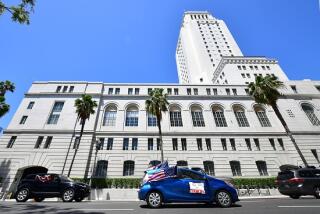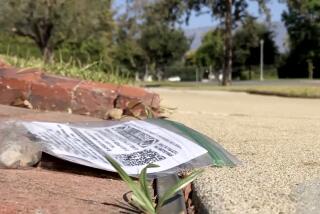With L.A. council, ceremonial nonsense gets in the way of real action
This has been such a busy year for members of the Los Angeles City Council, you have to wonder if their coffee is spiked with Red Bull.
OK, they may have dropped the ball on a few small things, including broken streets, mansionization and slow emergency response times. But consider all the things they’ve accomplished.
In February, for instance, the council renewed support for sanctions against Iran. Imagine the jolt that delivered to Tehran.
In April, they voted to ban elephant trainers in traveling circuses from using bull hooks within city limits. But the ban doesn’t take effect until 2017, so if you’ve got an elephant you’re fond of, my advice is that you park it in Burbank or Pomona for the next 27 months.
Also in April the council created Renter’s Day to highlight the need for more affordable housing, but at last check, even that radical action hadn’t made a dent in the problem.
In May, our city leaders passed a resolution urging administrators in the Rialto School District to express remorse for a project asking eighth-graders to decide whether the Holocaust actually occurred.
In June, the council delivered a proclamation honoring the 116th anniversary of Philippines Independence Day. A lazy City Council would have waited for the 120th anniversary.
Aug. 6 was declared El Salvador Day, Aug. 20 was selected as Jiff the Pomeranian Day. And then last week the council outdid itself, surpassing even its recognition of Meatless Mondays in 2012 or its declaration of support in 2013 for adjunct professors.
On Monday, City Council members moved forward to ban the growing of genetically modified crops in Los Angeles.
But they acknowledged the ban was “largely symbolic,” given the scarcity of farming in the city.
Symbolic, and nonbinding.
Then, on Tuesday, the council unanimously approved a resolution backing a UFW contract.
Not that it has any say in the matter.
The deal involves a grower in Fresno.
For all of this, I think the L.A. City Council still has a long way to go before topping the L.A. County Board of Supervisors. Each meeting of the supes begins with something resembling a variety show featuring lovable pets and legions of citizens who have done something worthy of a scroll, a tradition that threatens the very existence of Sequoia National Forest.
All of this, by the way, has a purpose: namely, to make sure that elected officials recognize the people who got them elected and remind those same people that the next election is never too far away.
To be fair, L.A. City Council members all do some good work in a job that’s harder that it might look. But ceremonial nonsense, which eats up a lot of staff time, is no substitute for real work. And that’s where we’ve got trouble.
On Thursday, we learned that if you need help in an emergency and dial 911 for the L.A. City Fire Department, you’ll wait three seconds longer on average than you would have waited a year earlier. This despite a three-year focus on the problem, a revelation that fire officials admitting fudging the stats, and demands for improvements from the City Council and mayor.
Where’s the official outrage, and will we have to wait until the 120th Philippines Independence Day to get the system fixed?
Meanwhile, the city has a projected $95-million budget deficit this year, with far deeper holes forecast in coming years. Speaking of holes, it’s possible to drive your car into one, but the council does not have a remedy in the works, unless it’s thinking of filling potholes with all the meat no longer being consumed on Mondays.
Money woes are one thing, but even when that’s not a huge factor in addressing a big problem, council members can’t seem to get out of first gear. Take, for instance, the mansionization issue my colleague Emily Alpert Reyes and I have written about.
Across the city, residents are waking up to the sound of bulldozers, only to find houses next door being leveled and structures the size of cargo ships rising in their place. You may have lived in your home for 40 years and suddenly you’ve lost your view and your sunlight, and the scale and character of the street are transformed.
There’s been an epidemic of these houses on steroids despite a mansionization ordinance enacted six years ago. Enraged citizens have risen up and three neighborhoods have won tighter restrictions, while many others try to follow suit.
But there’s a better fix. In May, Councilman Paul Koretz introduced a straightforward motion to close a few loopholes and reasonably scale back the size of new homes across the city. The proposal has languished, however, and planning officials now say it could take 18 months to get off the dime.
Eighteen months?
I hadn’t heard that much bureaucratic hooey since CalVet officials told me it would take two years to build a kitchen so they could fill the half-empty West L.A. home for ailing veterans.
“There is absolutely no reason why it should take 18 months,” said Dick Platkin, a former city planner who has joined homeowner activists.
Well, of course there’s a reason.
Developers, real estate speculators and home builders form a powerful lobby at City Hall. They have profited handsomely from the loopholes in the mansionization ban, and they don’t want them closed. They’re buying up more properties by the dozens, and if this drags on for another 18 months, they’ll make a killing.
If only council members were as worked up about neighborhood destruction as they are about GMOs, we might get a declaration calling for a temporary mansionization moratorium.
But let’s not be naive.
Smart money says we’re more likely to see a resolution demanding that ISIS express remorse for terrorism, unanimous support for Siamese Kitten Month, and yes, even a Developer Recognition Day.
More to Read
Start your day right
Sign up for Essential California for news, features and recommendations from the L.A. Times and beyond in your inbox six days a week.
You may occasionally receive promotional content from the Los Angeles Times.







